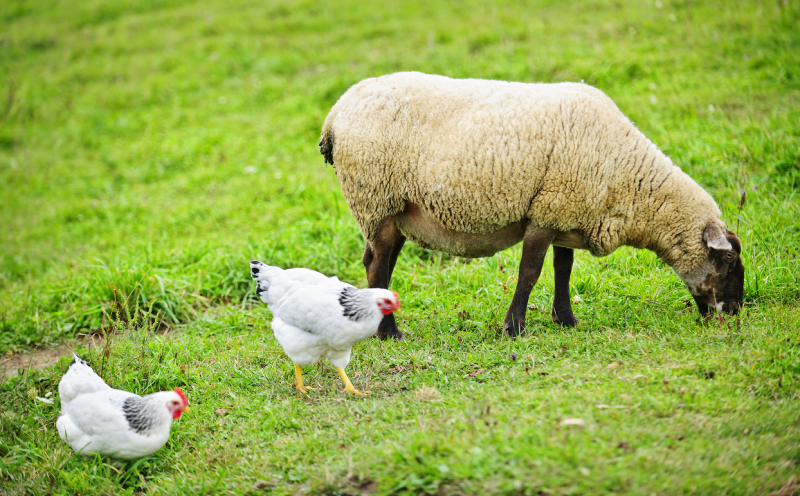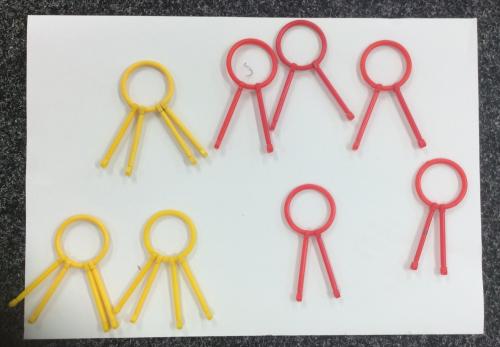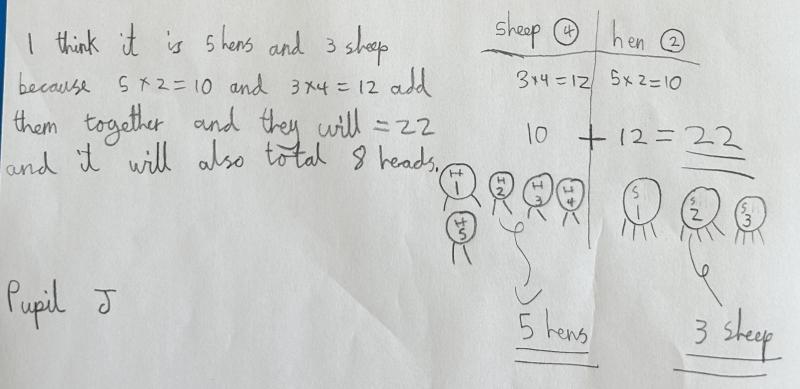Heads and feet
On a farm there were some hens and sheep. Altogether there were 8 heads and 22 feet. How many hens were there?
Problem
Heads and Feet printable sheet

On a farm there were some hens and sheep.
Altogether there were $8$ heads and $22$ feet.
How many hens were there?
What other numbers of feet are possible if there are 8 heads?
Create your own problem like this for a friend to try.
Getting Started
How many legs would eight hens have?
How many legs would eight sheep have?
What could you try next?
Student Solutions
Well done to everybody who worked out the number of hens and sheep on the farm. We'll be focusing here on the solutions which described a method for working out the answer.
Felicity from Anston Greenlands Primary School in the UK said:
After exploring using clever sticks - We found that there would be 5 hens
We used yellow Cleversticks to represent sheep and red to represent the hens.
We tried having less sheep, but then we ended up with more than 8 heads to get the total of 22 feet.

Emily from St Mary's CE Primary in England used a similar method:
I drew 8 circles for heads and shared the legs between them.
Alice and Kumi from CHPS in Australia got the same answer using a different method:
We worked this out by starting with random amounts of hens and sheep then used that information to work it out. The maths strategy we used was trial and error.
The children at Our Lady's Prep School in England had lots of different ideas about this problem. Their teacher sent in their thoughts:
Pupil P said: "5x2=10 and 3x4=12 10+12=22"
Pupil L - "I drew 22 lines and put them in groups of 2s and 4s -This came to 5 groups of 2 and 3 groups of 4"
Pupil A- "I tried 9 hens (18 legs) and 1 sheep (4 legs) (18+4=22) to get 22 legs but then we realised this wouldn't work becuase there are only 8 heads and my solution would have given us 10 heads"
Pupil J- worked it out using a table and diagrams. (This image can be clicked on to make it bigger.)

Archie from Mountains Christian College in Australia started with some sheep and then added hens:
I worked out that if there were three sheep that would equal 12 feet and three heads. I then started to draw hens one at a time. I got up to four hens which made 8 feet and 4 heads. Leaving me to draw one extra hen 1 head and 2 feet.
12 + 8 + 2 = 22 feet
3 + 4 + 1 = 8 heads
Maryam from Hollywood Primary in Australia worked systematically to find the solution:
I created a table and tried various combinations of sheep and hens that add up to 8 because there are 8 heads.
I first tried,
1 sheep + 7 hens = 18 feet
2 sheep + 6 hens = 20 feet
3 sheep + 5 hens = 22 feet.
I realised this was the answer. There are 3 sheep and 5 hens.
I wonder if going through these in order makes it easier to see a pattern in the number of feet? How many feet do you think 4 sheep and 4 hens would have?
Rihito from St Andrews International School in Thailand drew a diagram to solve this problem:
I used an area diagram to solve it. So firstly, I drew two rectangles to make the diagram, and at the very bottom, I wrote 8 which represents the heads. On the side of the small rectangle I wrote 2 (2 feet for hen) and on the side of the big rectangle I wrote 4 (4 feet for sheep). First I did 2 times 8 which equals 16. Then I did 4-2=2. After I subtracted 16 from 22 meaning the space left in the area diagram should be 6. So I divided 6 by 2 which is 3. Now, we know that there are 3 sheep. 8-3=5 so there are 5 hens. To check, we can see how much heads and feet the 3 sheep and 5 hens have in total. 3 sheep have 3 heads 5 hens have 5 heads. That makes 8 heads. Then 3 sheep have 12 legs, and 5 hens have 10 feet, in total there are 22 feet so we know that the answer 5 hens is correct.
What Rihito is talking about here is very similar to one possible way of using Felicity's Cleversticks in the image at the top of the page - we could start with 8 hens and then turn some of them into sheep by adding more legs! And Rihito knew there would be 3 sheep because there were 6 legs left over.
Emma from St Elizabeth Catholic Primary School in the UK worked out all the possible numbers of feet for animals with a total of 8 heads:
The total number of legs possible with 8 heads are:
. 30
. 28
. 26
. 24
. 22
. 20
. 18
I wonder how Emma worked this out?
Thank you as well to the following children who sent in similar solutions to this problem: Sas; Leonardo from ISB Bergamo in Italy; Elmaundi, Eli, Evie, Max, Murray, Eli, Montgomery and Maya from CHPS in Australia; the children from P3G at Kinnaird Primary School in Scotland; Matilde from Nyager in Denmark; and Ela from Murrayfield Primary in Turkey. It was very interesting to read all your thoughts about this.
Teachers' Resources
Why do this problem?
This is an easily presented problem that requires a bit of thinking as it's not necessarily obvious to pupils what needs to be done to obtain an answer. It demonstrates the power of trial and improvement, combined with a systematic approach and you could also use children's work to focus on different ways of representing a solution.
Possible approach
You might choose to start this activity by counting the children's legs - bring a group up to the front of the classroom and ask how many children there are, and then count the legs. What can they say about the numbers? If you told them how many legs there were, could they tell you how many children? Emphasise the connection and the inverse. (It's a good idea to resist the temptation to record this centrally so that in the later task children don't have a preconceived idea of how to record, and so may be inventive.)
Having helped the children to make the connection between children (heads) and legs, you could then introduce the idea of animals with different numbers. Which animals have two legs? Which have four? Do they know of any animals which have another number?
Then introduce the idea of two different animals. How many legs would a hen and sheep have altogether? If we know how many hens and how many sheep, can we work out how many legs? What about the other way round? Take some suggestions and then offer the task to the class.
Children could work in pairs or small groups. Once they have spent some time on the task, share different children's approaches and ways of recording. Look for children who have a system to their work, or identify a pattern in the solutions.
Key questions
Possible extension
Possible support
